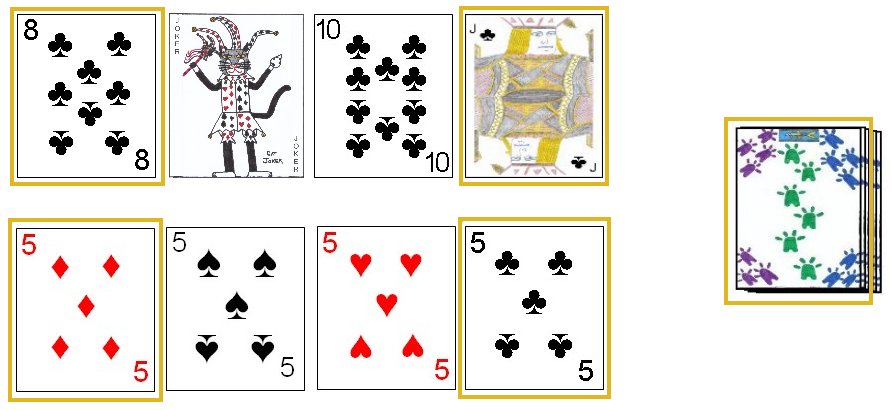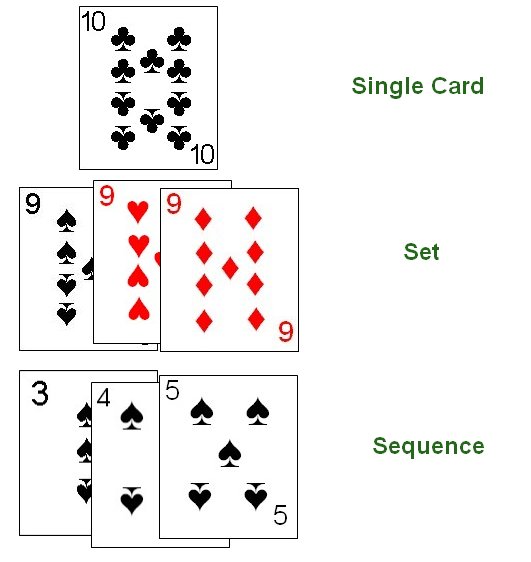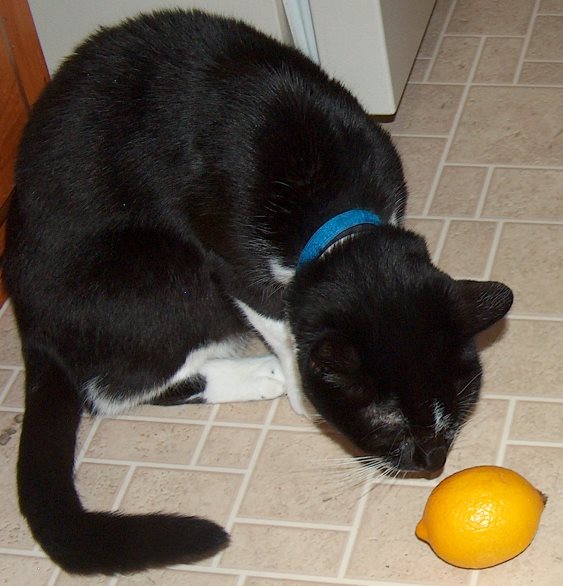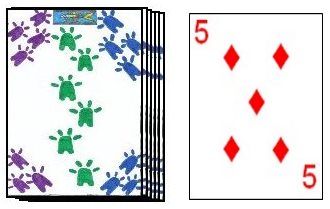On his turn, a player may make only one legal play, but that play may consist of multiple cards as appropriate (see below). The following shows the possible legal types of play a player can make on his turn:
- Single Card : A player may throw any one card from his hand on to the table. He would usually do this when he has no other legal plays which can be made.
- Same Rank Set : A player may throw two or more cards during his turn under the condition that all cards included as part of the play are of the exact same rank (i.e. three nines or three Kings). A Joker may never be used as part of a set.
- Sequence : A player may throw a sequence consisting of three or more cards. The cards must all be of the same suit and be in direct numerical sequence (i.e., the three, Four and Five all of Spades, or the ten, Jack, Queen and King all in the suit of Clubs). A sequence may contain one or more Jokers which can be used to substitute for any other card in the deck required to complete the sequence (for example, the three of Spades, Joker, Four of Spades and Five of Spades).
On each of these plays, all cards included are played face-up to the table.
 |
| In this illustration, the yellow borders show the allowable cards to be drawn by a player from the last played combination. |
After drawing a card the player then gathers up his thrown card or cards and places them face up in the play pile. The order they are gathered is important. For a sequence, these cards should be gathered in numerical order and placed on the pile. For a set, the player can gather them in any order. This is important as the next player can take only the first or last card from the previous players play (when multiple cards are played).
A player who calls "Yaniv" does not make any other plays on his turn other than the declaration. Once he makes this call, the hand immediately ends and all players must expose his hand for comparison against the player who called "Yaniv."
If the caller does in fact have the lowest total he scores 0 points and all other players score the number of points found in their hand.
However, if any other player has an equal or lower total than the Yaniv caller, the caller scores 30 points added to the number of points in his hand. All other players (including the opponent with the lowest total) score the total value of cards in his hand. This is called Asaf, and is often signified by the player with the lower total shouting "Asaf" when all cards are exposed.



 After the deal is complete, the player to the dealers immediate right has the first turn. On his turn a player is first required to make a play. He may play the card of his choice from his hand to start a play pile. If he has multiple cards of the exact same rank he may play all such cards on his turn. If the cards played are of the same rank as the previous top card on the play pile the player is not required to draw a card. However, if the cards were not of the same rank as the top card of the play pile (or the play pile was previously empty) he must draw a card. He may either draw the top card of the stock or one of the cards played by the player immediately previous to the current player. Alternatively, a player on his turn, before making a play, may Declare. A player must make the Declare at the beginning of his turn and may not make a play or discard on that turn. A player may not declare on his first turn, but may on any other of his turns in the hand. A player would Declare if he believed he had the lowest total count in cards in the current hand. The player may Declare with any total, but usually would wait until he had a low total to ensure he has the lowest total in hand. After a player makes a Declare, each other player, in turn, is allowed one more turn to try to reduce his total count.
After the deal is complete, the player to the dealers immediate right has the first turn. On his turn a player is first required to make a play. He may play the card of his choice from his hand to start a play pile. If he has multiple cards of the exact same rank he may play all such cards on his turn. If the cards played are of the same rank as the previous top card on the play pile the player is not required to draw a card. However, if the cards were not of the same rank as the top card of the play pile (or the play pile was previously empty) he must draw a card. He may either draw the top card of the stock or one of the cards played by the player immediately previous to the current player. Alternatively, a player on his turn, before making a play, may Declare. A player must make the Declare at the beginning of his turn and may not make a play or discard on that turn. A player may not declare on his first turn, but may on any other of his turns in the hand. A player would Declare if he believed he had the lowest total count in cards in the current hand. The player may Declare with any total, but usually would wait until he had a low total to ensure he has the lowest total in hand. After a player makes a Declare, each other player, in turn, is allowed one more turn to try to reduce his total count.